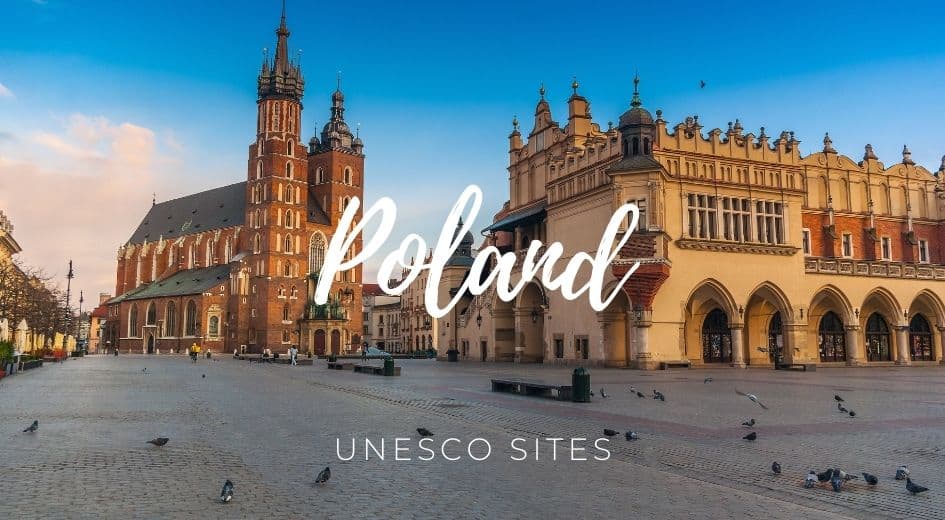Table of Contents


Poland UNESCO has registered 17 sites on the World Heritage list and 5 on the tentative list.
Some places are so interesting that it’s relevant to keep them for future generations. This is why UNESCO has built a list of crucial classified properties in which superb places stand out for their aesthetic, natural, artistic, or cultural significance.
More than a thousand places are registered as Unesco’s World Heritage worldwide. Due to my interest in visiting World Heritage sites, I compiled the UNESCO list in Poland and the corresponding map.
Poland UNESCO list
- Auschwitz Birkenau German Nazi Concentration and Extermination Camp
- Castle of the Teutonic Order in Malbork
- Centennial Hall in Wrocław
- Churches of Peace in Jawor and Świdnica
- Historic Centre of Kraków
- Historic Centre of Warsaw
- Kalwaria Zebrzydowska: the Mannerist Architectural and Park Landscape Complex and Pilgrimage Park
- Krzemionki Prehistoric Striped Flint Mining Region
- Medieval Town of Toruń
- Muskauer Park / Park Mużakowski
- Old City of Zamość
- Tarnowskie Góry Lead-Silver-Zinc Mine and its Underground Water Management System
- Wieliczka and Bochnia Royal Salt Mines
- Wooden Tserkvas of the Carpathian Region in Poland and Ukraine
- Wooden Churches of Southern Małopolska
- Ancient and Primeval Beech Forests of the Carpathians and Other Regions of Europe
- Białowieża Forest
Poland UNESCO Map
Click on the blue pins to view more relevant information about each World Heritage site in Poland.
Description
- Auschwitz Birkenau German Nazi Concentration and Extermination Camp – a former Nazi concentration and extermination camp where over a million people, mostly Jews, were killed during World War II.
- Castle of the Teutonic Order in Malbork – a medieval fortress once the headquarters of the Teutonic Knights in Poland.
- Centennial Hall in Wrocław – a historic building built in the early 20th century and considered a masterpiece of modern architecture.
- Churches of Peace in Jawor and Świdnica – a pair of wooden churches built in the 17th century as a symbol of religious tolerance in the region.
- Historic Centre of Kraków – a well-preserved medieval city center home to stunning architecture, historic landmarks, and cultural institutions.
- Historic Centre of Warsaw – featuring stunning architecture and historical landmarks such as the Royal Castle and Old Town Market Square.
- Kalwaria Zebrzydowska: the Mannerist Architectural and Park Landscape Complex and Pilgrimage Park – a pilgrimage complex that dates back to the 17th century and is considered one of the most important religious sites in Poland.
- Krzemionki Prehistoric Striped Flint Mining Region – an ancient mine once one of Europe’s largest producers of striped flint.
- Medieval Town of Toruń is a well-preserved medieval town with stunning Gothic architecture known for its gingerbread.
- Muskauer Park / Park Mużakowski – a historical landscape park that straddles Poland and Germany’s border.
- Old City of Zamość – a well-preserved Renaissance town built in the 16th century and known for its beautiful architecture and historical landmarks.
- Tarnowskie Góry Lead-Silver-Zinc Mine and its Underground Water Management System – a historic mine that dates back to the 18th century and features a unique underground water management system.
- Wieliczka and Bochnia Royal Salt Mines are historic salt mines that have operated for over 700 years.
- Wooden Tserkvas of the Carpathian Region in Poland and Ukraine – a collection of historic wooden churches built in the 16th and 17th centuries.
- Wooden Churches of Southern Małopolska – a collection of historic wooden churches that date back to the 15th and 16th centuries.
- Ancient and Primeval Beech Forests of the Carpathians and Other Regions of Europe – a collection of forests that have remained largely untouched for thousands of years, representing the continent’s primeval beech ecosystems.
- Białowieża Forest – a large primeval forest that straddles the border between Belarus and Poland, known for its biodiversity and the presence of the last remaining herd of European bison.
UNESCO World Heritage Sites in Poland have protected places for their cultural and natural importance.
Sites on the Tentative List
- Gdansk – Town of Memory and Freedom
- The Augustów Canal (Kanal Augustowski)
- The Dunajec River Gorge in the Pieniny Mountains
- Modernist Centre of Gdynia — the example of building an integrated community
- Paper Mill in Duszniki-Zdrój


